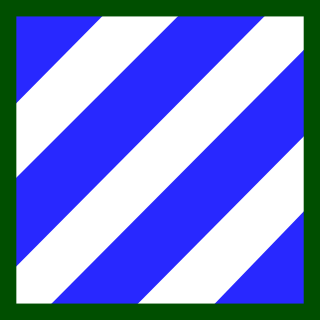
The 3rd Infantry Division (3ID) is a combined arms division of the United States Army based at Fort Stewart, Georgia. It is a subordinate unit of the XVIII Airborne Corps under U.S. Army Forces Command. Its current organization includes a division headquarters and headquarters battalion, two armored brigade combat teams, one aviation brigade, a division artillery, a sustainment brigade and a combat sustainment support battalion along with a maneuver enhancement brigade. The division has a distinguished history, having seen active service in World War I, World War II, the Korean War, and the Global War on Terror. The Medal of Honor has been awarded to 61 members of the 3rd Infantry Division, making the division the most honored in the Army.

The 1st Armored Division, nicknamed "Old Ironsides", is a combined arms division of the United States Army. The division is part of III Armored Corps and operates out of Fort Bliss in El Paso, Texas. It was the first armored division of the United States' Army to see battle in World War II. Since World War II, the division has been involved in the Cuban Missile Crisis, Persian Gulf War, Iraq, Afghanistan, and several other operations. The division has also received numerous awards and recognition.

V Corps, formerly known as the Fifth Corps, is a regular corps of the United States Army headquartered at Fort Knox, Kentucky and Camp Kościuszko, Poland.
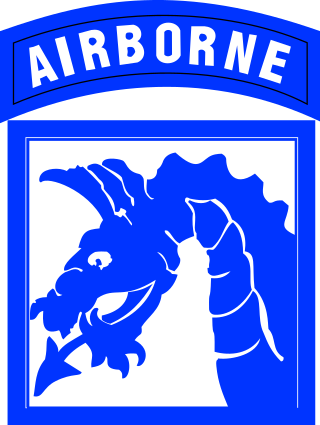
The XVIII Airborne Corps is a corps of the United States Army that has been in existence since 1942 and saw extensive service during World War II. The corps is designed for rapid deployment anywhere in the world and is referred to as "America's Contingency Corps." Its headquarters are at Fort Liberty, North Carolina.

The 1st Infantry Division (1ID) is a combined arms division of the United States Army, and is the oldest continuously serving division in the Regular Army. It has seen continuous service since its organization in 1917 during World War I. It was officially nicknamed "The Big Red One" after its shoulder patch and is also nicknamed "The Fighting First." The division has also received troop monikers of "The Big Dead One" and "The Bloody First" as puns on the respective officially sanctioned nicknames. It is currently based at Fort Riley, Kansas.

The 4th Infantry Division is a division of the United States Army based at Fort Carson, Colorado. It is composed of a division headquarters battalion, three brigade combat teams, a combat aviation brigade, a division sustainment brigade, and a division artillery.
The 2nd Brigade Combat Team, 1st Infantry Division, also known as the Dagger Brigade, is a maneuver brigade combat team in the 1st Infantry Division of the U.S. Army stationed in Fort Riley, Kansas.

Below is an estimated list of the major units deployed within the Multi-National Force – Iraq and other United States military units that were operating in Iraq under the U.S. Central Command (USCENTCOM) in 2009, during the Iraq War.

The reorganization plan of the United States Army was implemented from 2006 to 2016 under the direction of the Brigade Modernization Command. This effort formally began in 2006 when General Peter Schoomaker was given the support to move the Army from its Cold War divisional orientation to a full-spectrum capability with fully manned, equipped and trained brigades; this effort was completed by the end of 2016. It has been the most comprehensive reorganization since World War II and included modular combat brigades, support brigades, and command headquarters, as well as rebalancing the active and reserve components.

The 1st Engineer Battalion is a combat engineer unit of the United States Army that provides sustained engineer support across the full spectrum of military operations. The 1st Engineer Battalion is the oldest and most decorated engineer battalion in the US Army, tracing its lineage to the original Company of Sappers and Miners organized at West Point, New York in 1846.

Robert William Cone was a United States Army four-star general who last served as the commanding general of United States Army Training and Doctrine Command (TRADOC). He assumed command of TRADOC on April 29, 2011. He previously served as the commander of Fort Hood and III Corps on September 22, 2009, with which he deployed to Iraq in February 2010, and served as the Deputy Commanding General for Operations, United States Forces – Iraq, until February 2011. Prior to that, he served as the Special Assistant to the Commanding General of TRADOC. He retired in 2014.

The 53rd Infantry Brigade Combat Team is an infantry brigade combat team of the Florida Army National Guard. The 53rd Infantry Brigade is the largest National Guard unit in the state of Florida. The brigade was one of fifteen enhanced readiness brigades, designed and trained to support active duty divisions. The brigade includes 32 units in Florida and Alabama with 4,166 authorized personnel.

The 52nd Infantry Regiment is an infantry regiment of the United States Army.
The U.S. 41st Infantry Regiment is a regiment of the United States Army. Its 1st Battalion is currently assigned to the 2nd Stryker Brigade Combat Team, 4th Infantry Division. Its 3rd Battalion was assigned to the 1st Armored Brigade Combat Team, 1st Armored Division, which was replaced in 2018 by 4th Battalion, 70th Armor Regiment, 1st Brigade Combat Team, 1st Armored Division.
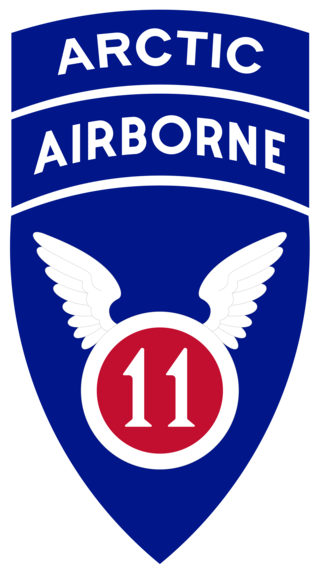
The 2nd Infantry Brigade Combat Team (Airborne), 11th Airborne Division is an airborne infantry brigade combat team (BCT) of the United States Army. The unit is stationed at Joint Base Elmendorf-Richardson in Anchorage, Alaska and is the only airborne brigade combat team in the Pacific Theater. It is also the newest airborne Infantry BCT and one of only five in the United States Army; the others are the three Infantry BCTs of the 82nd Airborne Division and the 173rd Airborne Brigade.
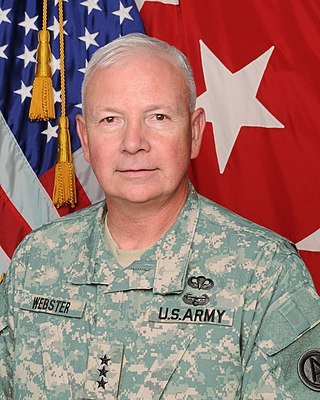
Lieutenant General William Glenn Webster is a retired senior officer in the United States Army and a former commander of the Third United States Army/United States Army Central. Webster assumed command of the Third Army/Army Central on May 9, 2009 from Lieutenant General James J. Lovelace and during his tenure was responsible for moving the Third Army's headquarters from Fort McPherson, where it had resided for 62 years, to Shaw Air Force Base in 2011. Webster was succeeded as commanding officer of the Third Army upon his retirement by Lieutenant General Vincent K. Brooks on June 3, 2011. While commanding Third Army, Webster oversaw the transition towards full-spectrum operations in the Third Army from a more narrow focus on combat operations as well as the Third Army's role in sustaining United States military activity in Iraq and Afghanistan.
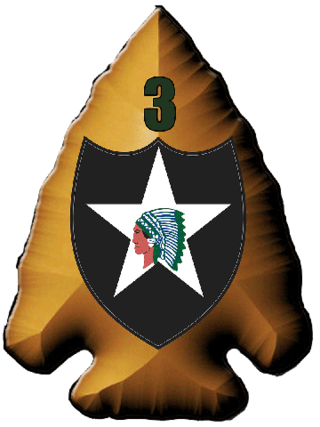
The 3rd Stryker Brigade Combat Team, 2nd Infantry Division is an inactive Stryker Brigade Combat Team of the United States Army's 2nd Infantry Division.

Paul Edward Funk II is a retired four-star general in the United States Army who last served as the commanding officer of the Army Training and Doctrine Command. He previously served as the 60th Commanding General of III Corps and Fort Hood, Texas, and as the Commanding General, Combined Joint Task Force – Operation Inherent Resolve. Funk was born at Fort Hood, Texas, graduated from Fort Knox High School, and was commissioned an Armor Officer through ROTC upon graduation from Montana State University in 1984. His first assignments saw him serve in a variety of Armor and Cavalry roles to include Tank Platoon Leader, Company Executive Officer, Squadron Commander of 1st Squadron, 7th Cavalry Regiment and Brigade Commander of 1st Brigade Combat Team, 1st Cavalry Division located at Fort Hood.

Dennis Scott McKean is a retired United States Army lieutenant general who last served as deputy commanding general for Army Futures Command and the Director, Futures and Concepts Center. He previously served as the chief of staff for United States Central Command.

John Buchanan Richardson IV is a retired United States Army major general. He served as Commanding General of the 1st Cavalry Division from July 2021 to July 2023. and Deputy Commanding General of the III Corps from September 2, 2020, to July 2021. Before that, he served as the Deputy Chief of Staff for Operations, Plans, and Training of the United States Army Forces Command. Richardson is a 1991 graduate of the United States Military Academy.
























